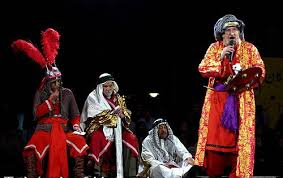
Tazieh, a unique Iranian theatrical form, is deeply rooted in Shia Islam and holds a significant cultural and spiritual role in Iran. Originating around the 7th century, it is a type of passion play that reenacts the martyrdom of Imam Hussein, the grandson of the Prophet Muhammad at the Battle of Karbala. Unlike traditional Western theater, Tazieh is a ritualistic performance meant to elicit emotions of grief, empathy, and solidarity with the suffering of Hussein and his family, who are seen as symbols of resistance against tyranny and injustice. Typically performed during the Islamic month of Muharram, Tazieh serves not only as a form of entertainment but as a communal, spiritual, and moral experience for both performers and audience.
One of the distinctive features of Tazieh is its use of symbolism and stylization rather than realism. The actors wear colored costumes and hold symbolic props that signify their roles and moral alignment, with green often representing Hussein and his supporters (symbolizing purity and justice), while red signifies his enemies (representing oppression and evil). The roles of female characters are typically portrayed by men dressed in veils or using symbolic gestures, maintaining traditional gender norms in Iranian culture. Each performance is accompanied by music, usually drums, cymbals, and horns, which enhance the solemnity and emotional intensity of the scenes.
Audience participation is another defining aspect of Tazieh. Unlike the passive spectatorship common in Western theater, audiences in a Tazieh performance engage emotionally and even vocally, expressing their grief through weeping and reciting verses. Sometimes, they actively interact with the actors, particularly those portraying Imam Hussein’s family, showing their allegiance and compassion by offering flowers or other tokens. The proximity between the actors and the audience blurs the line between performance and reality, immersing the audience in the narrative and creating a sense of shared mourning and devotion.
Despite facing suppression, Tazieh has persisted as a vital form of Iranian cultural and religious expression. Its influence can be seen not only in Iranian theater but also in other art forms. Today, Tazieh continues to be performed across Iran as a living tradition to respect and honor Imam Hussein.
Sources:
https://asiasociety.org/taziyeh-performance-conventions-short-sketch
https://ich.unesco.org/en/RL/ritual-dramatic-art-of-tazye-00377
Add comment
Comments